Sixties
City presents
a wide-ranging series of
articles on all aspects of the Sixties, penned by the creator of the iconic
60s music paper Mersey
Beat
|
Sixties
City presents
a wide-ranging series of
articles on all aspects of the Sixties, penned by the creator of the iconic
60s music paper Mersey
Beat
|
||||||
|
| Although Pop Art
originated in England in the mid-Fifties its most famous exponent during
the Sixties was Andy Warhol. Born Andrew Warhola in Philadelphia in 1928
of Czech immigrant parents he studied at Carnegie Institute as a painter.
During the Fifties, from his base in New York, he worked as a commercial
illustrator executing a variety of designs ranging from Christmas cards
to record sleeves and book illustrations, winning awards for the designs
he drew for the shoe manufacturer I.Miller. It was during the Sixties that Warhol emerged as one of the great contemporary artists, initially with his famous ’32 Soup Cans’, images of a Campbell’s soup can. His New York exhibition in 1962 displayed his fascination for brand-name objects such as Coca Cola bottles and for contemporary pop icons such as Marilyn Monroe and Elvis Presley. Among his exhibits were ‘Marilyn Monroe’s Lips’, ‘Gold Marilyn’, ‘Triple Elvis’, ‘Silver Marlon’, ‘Cagney’, ‘Ginger Rogers’ and ‘Troy Donaghue.’ Further Elvis images appeared in his 1963 exhibition – alongside portraits of Liz Taylor. During that year he moved into an abandoned firehouse on East Eighty-Seventh Street, a premises which he dubbed ‘the Factory.’ He also made sculptures of Brillo soap pads and was soon turning everyday items such as toothpaste cartons into icons. In his 1964 exhibition he displayed his box sculptures of Kellogg’s Corn Flakes, Mott’s Apple Juice, Heinz Ketchup and Del Monte Vegetables. Warhol was often ambiguous when discussing his work and was occasionally prone to creating practical jokes. When asked about his Campbell's Soup images he said that they reminded him of his childhood because he ate Campbell's Soup every day. Commenting on his work, he said, “If you want to know all about Andy Warhol, just look at the surface of my paintings and films and me, and there I am. There’s nothing behind it.” In 1965 he announced he had retired as an artist and would concentrate on making films. Although he did devote a great deal of his energy to film-making, he continuted with his artwork. In 1967 his celebrity had resulted in him being in great demand on the college lecture circuit. Previously, because he admitted to being too shy to speak in front of audiences, he had taken some of his ‘superstars’ along on the lecture tours and would sit quietly on stage while they would speak on his behalf. In 1967, dreading a new round of public speaking, he sent Allen Midgette, one of the actors in his films, on the circuit to pose as him with his hair sprayed silver. Midgette would sit quietly on stage while Paul Morrissey would speak on Warhol’s behalf. This ruse succeeded for four months before it was exposed. In 1969 he told a magazine that he didn’t do any art anymore, that all his new soup cans had been painted for him by Brigid Polk. This ruse nearly backfired as European collectors began to take the statement seriously – so he had to admit that he’d only been joking. |
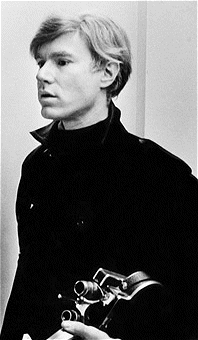 |
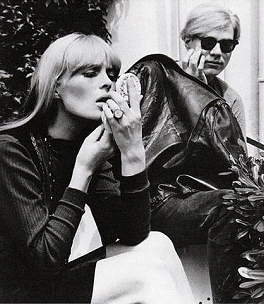 |
The innovative
artist became involved in avant-garde film-making from his base ‘the Factory’
in Manhatten, with a selection of artists who became ‘underground’ stars
– Edie Sedgwick, Joe D’Alessandro, Viva, Ingrid Superstar, Holly Woodlawn
and Sylvia Miles. His many films included ‘Kiss’ (1963), a close-up of couples
kissing; ‘Eat’ (1963) a 45-minute film depicting pop artist Robert Indiana
eating a mushroom; ‘Haircut’ (1963) a 33-minute film of a youth having his
hair cut; ‘Shoulder’ (1964) a close-up of dancer Lucinda Child’s shoulder,
which lasted four minutes and ‘Face’ (1965) an hour-long film close-up of
Edie Sedgwick’s features. Among his other numerous movies were: ‘Kitchen’ (1965); ‘Empire’ (1965); ‘My Hustler’ (1965); ‘Chelsea Girls’ (1966); ‘Blue Movie’ (1960) and ‘Women in Revolt’ (1972). After 1968, apart from ‘Women In Revolt’, the films were directed by Paul Morrissey while Andy remained as producer. The movies became more commercial and included ‘Flesh’ (1968); ‘Trash’ (1970) and ‘Heat’ (1974). The silver-haired Warhol, who had a collection of 50 wigs, also expressed an interest in music at ‘the Factory’ and became involved with the Velvet Underground, who comprised Lou Reed, John Cale and a female drummer, Maureen Tucker. Warhol was intrigued by German actress Nico and arranged for the Velvet Underground to become her backing band. In 1968 he was shot, almost fatally, by a militant feminist, Valerie Solanas, the only member of an organisation called SCUM (Society For Cutting Up Men). Three hours after the shooting, Solanas gave herself up to the police. Her bullets had struck both of Andy’s lungs, his stomach, his liver, spleen and oesophagus and he had to spend two months in hospital and several further months recuperating. Solanas died in 1988. A film ‘I Shot Andy Warhol’ was released in 1996 with Lili Taylor as Solanas and Jared Harris as Warhol. In 1969 he became involved in the launching of a magazine called 'Interview'. During the Seventies his artwork was inspired by fashion and show business. As a contrast to the early Sixties when he was painting his heroes such as Marilyn and Elvis, who he hadn’t met, he now mixed freely and became friendly with many stars, ranging from Lisa Minelli to John Lennon. Tragically, Andy Warhol died in a New York Hospital in 1987 following what was generally considered to be a routine operation. |
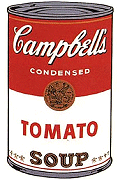 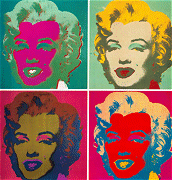 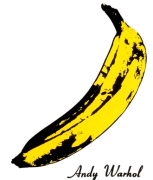 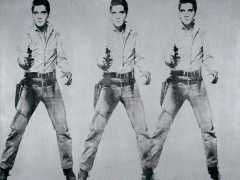 |
Batman Dracula is a 1964 American
film, produced and directed by Andy Warhol without the permission of DC
Comics and was screened only at his art exhibitions. Warhol was a 'Batman'
fan and the movie was his 'homage' to the character and contains what is
probably the first appearance of a blatantly campy Batman. The film was thought to have been lost, until scenes from the picture were shown at some length in the 2006 documentary Jack Smith and the Destruction of Atlantis. This is a restored 'trailer' for the film. |
|
Article
|